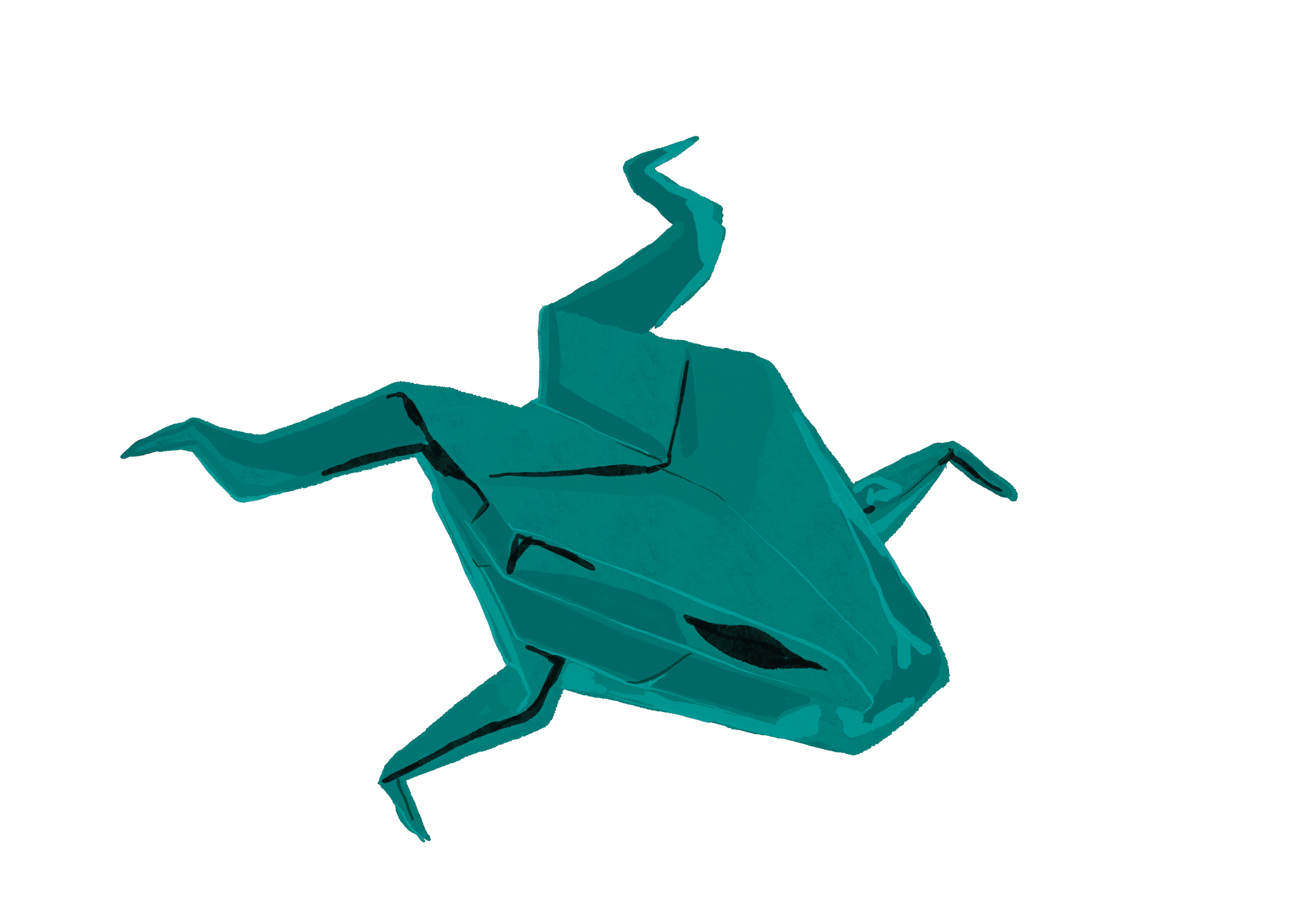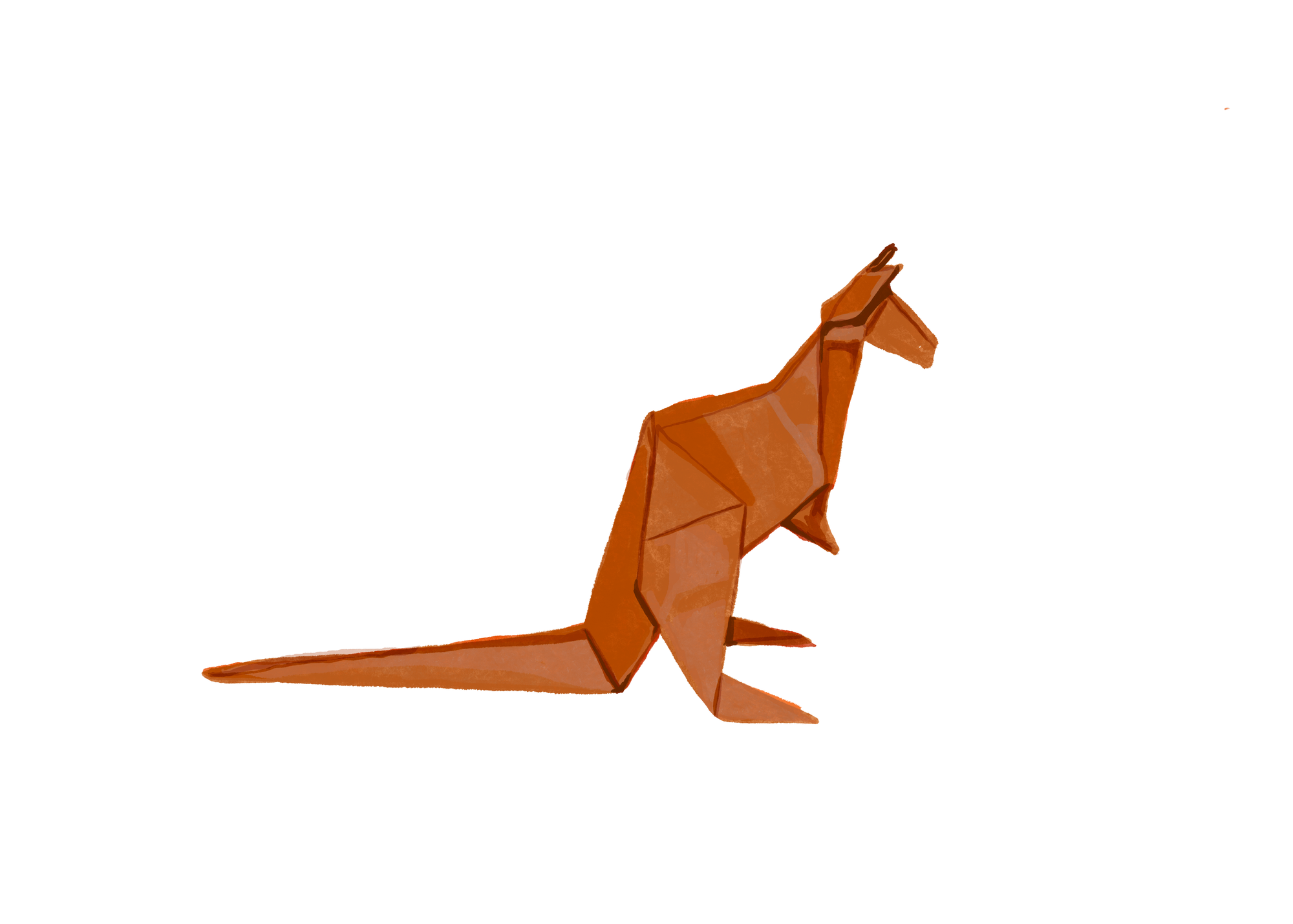When my dad died, I went through life feeling completely bereft. I was drowning under the weight of college exams and papers, funeral service preparations, and the omnipresent belief that nothing in my life would ever be the same again. In the hushed, hollow moments when I felt the emptiest, I turned to making art. I pressed the flowers people gifted us, strung up the origami my dad made, and painted until I felt I had created something beautiful. In the overwhelming presence of grief, depression, anxiety, and pain, reflecting on myself and my art led me to a more hopeful future. I was able to create meaningful ties back to my dad, who created origami artwork from the moment he was diagnosed with brain cancer up until the last weeks of his life.
The first prominent use of art therapy was in the 1940s for tuberculosis patients, when patients noticed the therapeutic effects of making art [1]. Since then, art therapy has expanded to provide a form of treatment that is able to be customized to an individual’s needs. From patients with traumatic brain injuries, to adolescents who have been abused, and even to people at the end of their lives, art therapy has been shown to provide a widely accessible and creative form of treatment [1]. Making art continuously provides new ways to process an illness, especially for those who have been facing ongoing struggles.
For various chronic conditions—be it cancer, Alzheimer’s, or mental illness—art provides a broad form of treatment that can be personalized to each patient [2]. Chronic diseases are illnesses lasting over a year, often negatively affecting a person’s day-to-day life. These conditions are often accompanied by long-term stress. In general, chronic stressors can cause detrimental effects on the body and mind. Anxiety and mood disorders like depression work in tandem with chronic physical symptoms, such as pain and weakness, to produce a variety of negative outcomes for patients. These include negative medical prognoses of the original condition, as well as additional symptoms. Different chronic stressors and their side effects can contribute to health-related disabilities, work impairment, imbalances in the immune system, and overall declines in quality of life [3][4]. As such, chronic stressors are one of the most important factors to target when considering treatment. In this respect, art can be a versatile tool to reduce the effects of these chronic stressors.
Mindfulness in Art
The technique of centering therapy on art allows patients to communicate their emotions and thoughts metaphorically, which aids patients in expressing or processing experiences that are difficult to share. In a medical context, utilizing art provides an alternative way for patients to receive treatment. In conjunction with mindfulness-based techniques, art therapy is a unique way to provide comfort in a meaningful way to many populations that feel discomfort in verbally sharing their emotions.
One promising new treatment of this category is mindfulness-based art therapy (MBAT). MBAT is distinct from other forms of cognitive and behavioral therapy because it combines meditative practices with the process of making art [2]. An example of MBAT would be a weekly painting session followed by a guided meditation on artwork made. It can also be implemented as a one-time intervention rather than a long-term procedure in order to target acute or unusual stress in a person’s life.
Some prominent effects of mindfulness that reduce the impacts of stress are improved sleep quality and improved regulation of cortisol, the primary stress hormone in humans [5][6]. High sleep quality leads to health benefits such as improved immune system and overall health, while better management of cortisol levels helps to keep the body and mind functioning under less stress. Mindfulness has also been linked to increased grey matter in a region of the brain called the posterior cingulate cortex (PCC), an area of the brain associated with self-awareness and emotion, even in older adults [7]. Generally, a greater proportion of grey matter in the brain is associated with better cognitive function, while a loss of grey matter results from dementia. MBAT as a therapy is then especially valuable for older adults who have had little exposure to meditation, as it is a low-stakes way to regularly introduce mindfulness practices into one’s routine with the added benefit of protecting against mental decline.
Another application of MBAT is to treat people suffering from mood-related disorders. As previously mentioned, the left PCC is closely connected to how the brain processes emotions. One research study associated greater brain volume of PCC to less depressive symptoms [8]. Another study found that there was reduced activation of the PCC in response to stressful cues in the MBAT intervention group compared to the control, which may indicate that patients who participate in MBAT have a reduced neurological response to stress [9]. In other words, mindfulness and art may be able to increase grey matter in the left PCC, as well as increase resilience to stress. This explains how MBAT can ease the emotional burden on patients who are suffering from complex illnesses. The positive effects from mindfulness alone, such as better management of cortisol and decreased depression, are synergistically combined with art therapy’s own unique biological benefits, as well.
Biological Mechanisms of Art Therapy
Recent studies on art therapy and MBAT in particular have led to discoveries about how making art affects visual processing in the brain, cortisol levels, and immune responses in the body. For patients afflicted by chronic conditions or severe illness, more notable effects of art therapy are increased feelings of relaxation and emotional healing, as well as increased resilience against physical stress.
Scientists have hypothesized that the process of art-making has potential rehabilitative effects partially because it relies on visual attention. This was explored in patients suffering from Parkinson’s disease (PD), all of whom had an abnormal baseline for visual-cognitive function and eye movements [10]. PD can cause uncontrolled movements in patients, and the goal of the study was to see if making art could improve visuospatial skills. Researchers conducted 20 sessions of art therapy twice a week for ten weeks and found that PD patients performed better on eye-tracking tests at the end of the study than they did before having art therapy. Each patient also had MRI scans taken before and after the study. These MRI scans show detailed three-dimensional images of the brain, and the results of the study pointed to increased functional connectivity in the V1 and V2 brain networks, which primarily govern vision. This indicates that creating art can strengthen and improve overall visual-cognitive skills and motor function in patients [10].
Researchers also looked at how making art affects cortisol. Cortisol levels in saliva samples were collected before and after 45 minutes of making art, and were found to be lower overall after just one art session [11]. In another study that specifically looked at MBAT for breast cancer patients, researchers found increased cerebral blood flow to the left caudate, a region of the brain involved with memory and emotion, after an eight-week period [9]. The increased blood flow indicated greater activity, which was correlated to decreased anxiety [9]. Increased processing in that area of the brain could have facilitated emotional regulation, and as a result decreased levels of anxiety.
In one study, scientists found that making art is also linked to an increased natural killer cell count, which improves immune responses to bacteria and viruses [12]. There was also a significant decrease in stress-associated protein expression that indicated increased immune responses and function in patients who had undergone art therapy. Additionally, this study investigated the calming effects of art therapy in the context of treating patients with alcohol use disorder (AUD). Making art facilitated positive emotional and spiritual change, which made MBAT an especially effective aid for rehabilitation purposes [12].
Each medium of art can have varied effects, meaning that patients may choose different types of art to create if they have different goals on what they would like to target. For example, a study found that clay sculpting had the effects of producing brain waves that promoted feelings of relaxation and which are highly associated with states of healing and emotion [13]. Drawing had the effect of increasing connectivity between areas of the brain involved in perception and memory. It is possible that the more three-dimensional forms of art, such as sculpting or making origami, inherently may have a greater benefit, but creating different mediums of art and their individual effects is an area of study that requires more research.
The current viability of MBAT as a therapy is centered on the notion that patients are able to obtain all of these benefits from art therapy as long as they are directly involved in creating art themselves, rather than solely appreciating or analyzing it. In a study comparing the effects on the brain of making versus evaluating art, researchers found that producing visual art increased functional connectivity in the PCC of the brain [14]. This increased functional connectivity was also linked to increased resilience, or stress resistance. These positive effects were not observed for patients who simply participated in cognitive art evaluation rather than art production [14]. This is part of the reason why MBAT is particularly effective, as it combines art production with mindfulness in order to compound the benefits with those of art therapy.




Art in Medicine
One of the most characteristic benefits of art therapy is a significant decrease in depression for patients suffering from chronic illnesses [15]. This effect has been noted in several studies done on different groups of cancer patients, providing further evidence of its therapeutic utility.
The association between art therapy and reduced depression in patients with chronic illnesses may be associated with how making art may be able to promote emotional processing. For a diagnosis that is as complex and life-altering as cancer often is, acceptance and resilience play a large part in how patients process their illness. Research on breast cancer patients has found that emotional awareness and acceptance are associated with improved health outcomes, and that art therapy is a viable way to facilitate this [16].
Another pilot study expanded on these results by exploring how art therapy also influenced pain and distress in cancer patients, this time with a greater range of art mediums and techniques such as painting, drawing, clay work, and collages [17]. After each patient received an individual art therapy session, the art therapist would guide the patient to reflect on their art. The results suggested that art therapy was also able to improve mood and reduce pain levels in the majority of cancer patients receiving treatment. These effects lasted at least two to three days after the treatment for all types of cancers. One additional benefit observed was immediate decreased emotional distress and anxiety, although this benefit was not retained in a follow-up with patients three days after going through art therapy [17]. This may show that art therapy works best as a continuous treatment in order to maintain the advantages of MBAT.
Overall, art therapy can utilize emotional processing as a mechanism not only to target depression, but also reduce somatic symptoms in cancer patients [16]. Researchers created a 12-week study program with a professional painter to offer watercolor painting art therapy to cancer patients undergoing chemotherapy [18]. Patients were offered guided painting instruction while in the care unit, and were also supplied with art materials for home practice. The group of patients who took part in the study showed an impactful improvement in their overall quality of life, as well as depression symptoms. They also found that the intervention group had decreased psychosomatic distress symptoms, such as shortness of breath, drowsiness, and fatigue. The benefits were even more pronounced especially for patients who had never been exposed to art therapy. Beyond being an enjoyable experience for all of the patients involved, the study results showed that clinics are able to implement art therapy as a method to improve patient care [18]. This is important because the experience of undergoing chemotherapy can be painful and exhausting, and having a therapy that patients were able to bring home highlights how art therapy can make intense medical treatments more bearable.
For patients suffering from cancer, art therapy has been used with some subjective degree of benefit, because each patient’s history with art and response to cancer is an individualized experience. One of the best examples of the benefits of art therapy is my father, who used origami as a method to deal with the stress that undergoing chemotherapy put on him. Origami kept his fine motor skills sharp, and he was always able to carry paper with him to his doctor’s appointments to make small creatures and flowers for my mother. It was additionally a meaningful art form for him because it was something he had been skilled at for many years. For most chemotherapy patients, this kind of portable, accessible therapy is not readily available.
Addressing Accessibility & Further Questions
Despite this range of benefits, art therapy is not necessarily the most financially accessible treatment for patients with chronic illness. Although it can be generally implemented for many people who are suffering from chronic illnesses, MBAT comes with its own unique costs, especially for the supplies needed to facilitate it. In a report investigating the cost and benefits of MBAT compared to a regular breast cancer support group (BCSG), researchers found that MBAT costs about $1000 on average per patient, while BCSG only cost about $550 per patient [19]. In the study, the BCSG group received weekly educational lectures and opportunities for group discussion to facilitate peer support, while the MBAT group learned mindfulness techniques and art therapy strategies, and also received homework assignments. The stress-reduction benefits for MBAT and BCSG were similar, which raises the question of the real efficacy of MBAT [19].
One of the unique aspects about MBAT is that it is a treatment that is widely generalizable and accessible to many different groups of people, and goes beyond treating patients who are suffering from chronic illness. For example, it can be an effective treatment for people with mild cognitive impairment [20]. Researchers performed a study that compared the effects of visual art therapy with health education sessions among older adults with mild cognitive impairment and low education levels. The group who went through the art intervention had greater improvement in global cognition and depression, and these increased levels of cognitive function continued to persist three and six months after the art intervention [20].
For students in college who regularly experience acute levels of stress, art therapy could even be implemented in online models in order to increase accessibility and flexibility of receiving therapy [1]. It is possible to design a method of therapy that people can follow along at home on a day-by-day basis, which may reduce barriers to accessibility of MBAT, and demonstrates how it can be a good at-home therapy method for college students. This online approach to therapy may also provide a readily available form of treatment for groups that have difficulty obtaining healthcare, such as veterans. In people dealing with combat trauma, MBAT has been shown to be an effective therapy to alleviate the symptoms of traumatic brain injury or post-traumatic stress disorder [21]. Ultimately, the value of art therapy lies in its ability to produce tangible, visible improvement in quality of life for patients.
In order to better understand the potential of MBAT, further studies are needed to explore the different biological and behavioral factors that can lead to more therapeutic success. In particular, MBAT studies that have participants creating different forms of art may be able to investigate different benefits and effects that particular art mediums have on people [22].
An analysis of the major research done on MBAT highlights some of the flaws in the standardization of current studies, with major variations in forms of illness, severity of anxiety and mood disorders, as well as the time since diagnosis [23]. Art therapy generally was able to effectively relieve anxiety and depression in patients with cancer, but the effects seemed to drop off after the 12-week mark during follow-ups [23]. More research is needed to determine how long the benefits of MBAT last, and if there are ways to prolong or maximize said benefits past the duration of a set course of therapy.
At this point, research on the potential benefits of art therapy is still ongoing, and the different effects of various forms of MBATs are not well-understood, because there are so many possibilities for implementing it into patient care. From a study comparing creative therapies to mind-body focused therapies, relatively little difference was found between the two groups who participated in the study [24]. There were some MBATs that were highlighted as having benefits for emotional regulation strategies, but art therapy as a catch-all therapy for patients is certainly not a foregone conclusion.
Conclusion
Despite the fact that MBAT is still a currently understudied form of therapy, it has been predominantly used with great success in trials studying breast cancer patients. Trials of MBAT in various studies may differ in length, art mediums, and patient demographics, but all studies emphasize mindfulness practices. In combining the effects of meditative and art treatments, patients are able to significantly reduce anxiety and depression levels, as well as improve cognition and resilience. Even if a person is not necessarily suffering from a chronic illness, MBAT can still provide all of these benefits at a relatively low cost.
One of the most poignant aspects of art is that people can impart their own experiences and life into a tangible object that stays for a long time. Mindfulness-based art therapy is something that not only helps the patient, but also the people they love. Although my dad is gone, I am still able to look at the art he made. I am able to touch the flowers and animals he designed himself, and I can remember the way he spent hours picking out his favorite papers and glues, and how he refined and made his own techniques. I can see the proof of his skill and memory and the love he left behind. Creating something physical, beyond the emotional and somatic benefits, is evidence that one’s story is real, impactful, and beautiful in its own right.
References
- Bitonte, R. A., & De Santo, M. (2014). Art Therapy: An Underutilized, yet Effective Tool. Mental illness, 6(1), 5354. https://doi.org/10.4081/mi.2014.5354
- Beerse, M. E., Van Lith, T., & Stanwood, G. (2020). Therapeutic psychological and biological responses to mindfulness-based art therapy. Stress and health : journal of the International Society for the Investigation of Stress, 36(4), 419–432. https://doi.org/10.1002/smi.2937
- Bokma, W. A., Batelaan, N. M., van Balkom, A. J., & Penninx, B. W. (2017). Impact of Anxiety and/or Depressive Disorders and Chronic Somatic Diseases on disability and work impairment. Journal of psychosomatic research, 94, 10–16. https://doi.org/10.1016/j.jpsychores.2017.01.004
- Ménard, C., Pfau, M., Hodes, G. et al. Immune and Neuroendocrine Mechanisms of Stress Vulnerability and Resilience. Neuropsychopharmacol 42, 62–80 (2017). https://doi.org/10.1038/npp.2016.90
- Black DS, O'Reilly GA, Olmstead R, Breen EC, Irwin MR. Mindfulness meditation and improvement in sleep quality and daytime impairment among older adults with sleep disturbances: a randomized clinical trial. JAMA Intern Med 2015; 175:494–501
- Brand, S., Holsboer-Trachsler, E., Naranjo, J. R., & Schmidt, S. (2012). Influence of mindfulness practice on cortisol and sleep in long-term and short-term meditators. Neuropsychobiology, 65(3), 109–118. https://doi.org/10.1159/000330362
- Kurth, F., Luders, E., Wu, B., & Black, D. S. (2014). Brain Gray Matter Changes Associated with Mindfulness Meditation in Older Adults: An Exploratory Pilot Study using Voxel-based Morphometry. Neuro : open journal, 1(1), 23–26. https://doi.org/10.17140/NOJ-1-106
- McLaren M. E., Szymkowicz S. M., O’Shea A., Woods A. J., Anton S. D., Dotson V. M. Dimensions of depressive symptoms and cingulate volumes in older adults. Translational Psychiatry. 2016;6(4, article e788) doi: 10.1038/tp.2016.49.
- Monti, D. A., Kash, K. M., Kunkel, E. J., Brainard, G., Wintering, N., Moss, A. S., Rao, H., Zhu, S., & Newberg, A. B. (2012). Changes in cerebral blood flow and anxiety associated with an 8-week mindfulness programme in women with breast cancer. Stress and health : journal of the International Society for the Investigation of Stress, 28(5), 397–407. https://doi.org/10.1002/smi.2470
- Cucca, A., Di Rocco, A., Acosta, I., Beheshti, M., Berberian, M., Bertisch, H. C., Droby, A., Ettinger, T., Hudson, T. E., Inglese, M., Jung, Y. J., Mania, D. F., Quartarone, A., Rizzo, J. R., Sharma, K., Feigin, A., Biagioni, M. C., & Ghilardi, M. F. (2021). Art therapy for Parkinson's disease. Parkinsonism & related disorders, 84, 148–154.
- Kaimal, G., Ray, K., & Muniz, J. (2016). Reduction of Cortisol Levels and Participants' Responses Following Art Making. Art therapy : journal of the American Art Therapy Association, 33(2), 74–80. https://doi.org/10.1080/07421656.2016.1166832
- Kang, S. J., Pei, C. Z., Lee, D. H., Ha, J. E., & Baek, K. H. (2023). A pilot randomized clinical trial of biomedical link with mental health in art therapy intervention programs for alcohol use disorder: Changes in NK cells, addiction biomarkers, electroencephalography, and MMPI-2 profiles. PloS one, 18(5), e0284344.
- Kruk, K. A., Aravich, P. F., Deaver, S. P., & deBeus, R. (2014). Comparison of Brain Activity During Drawing and Clay Sculpting: A Preliminary qEEG Study. Art Therapy, 31(2), 52–60. https://doi.org/10.1080/07421656.2014.903826
- Bolwerk, A., Mack-Andrick, J., Lang, F. R., Dörfler, A., & Maihöfner, C. (2014). How art changes your brain: differential effects of visual art production and cognitive art evaluation on functional brain connectivity. PloS one, 9(7), e101035. https://doi.org/10.1371/journal.pone.0101035
- Pongan, E., Tillmann, B., Leveque, Y., Trombert, B., Getenet, J. C., Auguste, N., Dauphinot, V., El Haouari, H., Navez, M., Dorey, J. M., Krolak-Salmon, P., Laurent, B., Rouch, I., & LACMé Group (2017). Can Musical or Painting Interventions Improve Chronic Pain, Mood, Quality of Life, and Cognition in Patients with Mild Alzheimer's Disease? Evidence from a Randomized Controlled Trial. Journal of Alzheimer's disease : JAD, 60(2), 663–677. https://doi.org/10.3233/JAD-170410
- Czamanski-Cohen, J., PhD, Wiley, J. F., PhD, Sela, N., BA, Caspi, O., MD, PhD, & Weihs, K., MD (2019). The role of emotional processing in art therapy (REPAT) for breast cancer patients. Journal of psychosocial oncology, 37(5), 586–598. https://doi.org/10.1080/07347332.2019.1590491
- Elimimian, E. B., Elson, L., Stone, E., Butler, R. S., Doll, M., Roshon, S., Kondaki, C., Padgett, A., & Nahleh, Z. A. (2020). A pilot study of improved psychological distress with art therapy in patients with cancer undergoing chemotherapy. BMC cancer, 20(1), 899. https://doi.org/10.1186/s12885-020-07380-5
- Bozcuk, H., Ozcan, K., Erdogan, C., Mutlu, H., Demir, M., & Coskun, S. (2017). A comparative study of art therapy in cancer patients receiving chemotherapy and improvement in quality of life by watercolor painting. Complementary therapies in medicine, 30, 67–72. https://doi.org/10.1016/j.ctim.2016.11.006
- Prioli, K. M., Pizzi, L. T., Kash, K. M., Newberg, A. B., Morlino, A. M., Matthews, M. J., & Monti, D. A. (2017). Costs and Effectiveness of Mindfulness-Based Art Therapy versus Standard Breast Cancer Support Group for Women with Cancer. American health & drug benefits, 10(6), 288–295.
- Masika, G. M., Yu, D. S. F., Li, P. W. C., Lee, D. T. F., & Nyundo, A. (2022). Visual Art Therapy and Cognition: Effects on People With Mild Cognitive Impairment and Low Education Level. The journals of gerontology. Series B, Psychological sciences and social sciences, 77(6), 1051–1062. https://doi.org/10.1093/geronb/gbab168
- Magsamen S. (2019). Your Brain on Art: The Case for Neuroaesthetics. Cerebrum : the Dana forum on brain science, 2019, cer-07-19.
- Beerse, M. E., Van Lith, T., Pickett, S. M., & Stanwood, G. D. (2020). Biobehavioral utility of mindfulness-based art therapy: Neurobiological underpinnings and mental health impacts. Experimental biology and medicine (Maywood, N.J.), 245(2), 122–130. https://doi.org/10.1177/1535370219883634
- Zhang, M. F., Wen, Y. S., Liu, W. Y., Peng, L. F., Wu, X. D., & Liu, Q. W. (2015). Effectiveness of Mindfulness-based Therapy for Reducing Anxiety and Depression in Patients With Cancer: A Meta-analysis. Medicine, 94(45), e0897. https://doi.org/10.1097/MD.0000000000000897
- Le Rhun, A., Caillet, P., Lebeaupin, M., Duval, M., Guilmault, L., Anthoine, E., Borghi, G., Leclère, B., & Moret, L. (2023). Mind-body and art therapies impact on emotional regulation in patients with chronic diseases: a pragmatic mixed-methods randomized controlled trial. BMC complementary medicine and therapies, 23(1), 344. https://doi.org/10.1186/s12906-023-04173-8
